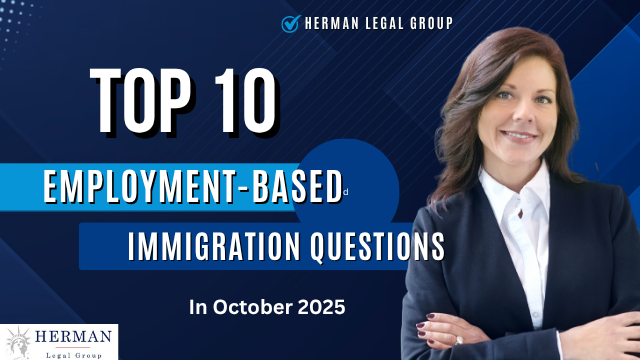Introduction
In October 2025, marriage-based green cards remain one of the most common—and complex—paths to U.S. permanent residence. With new USCIS backlogs, updated public-charge guidance, and rising fraud-detection scrutiny, couples are asking thousands of questions online.
Below, immigration attorney Richard T. Herman, Esq., who has practiced immigration law for over 30 years, answers the 10 most searched and discussed questions about marriage green cards,

1. What documents prove a “bona fide” marriage for USCIS?
To prove a bona fide marriage, USCIS expects extensive shared evidence of life together—financial, residential, and social.
USCIS officers evaluate whether your marriage was entered “in good faith” rather than for immigration benefits. Evidence categories include:
- Financial: joint bank accounts, tax returns, insurance, loans, credit cards.
- Residential: lease or deed showing both names, utility bills, mail addressed jointly.
- Social: wedding photos, invitations, travel itineraries, affidavits from friends or relatives.
- Children: birth certificates or adoption papers showing both spouses.
USCIS lists recommended examples in the Form I-130 instructions and Policy Manual Vol. 12, Pt. G, Ch. 2.
Pro tip: Bring originals and organized copies to your interview, labeled by category.
2. What kinds of questions do officers ask at the marriage green card interview?
Interview questions test the authenticity of your relationship and daily life.
Expect questions about:
- How you met and decided to marry
- Daily routines (meals, chores, work schedules)
- Major life events (holidays, family visits, future plans)
- Living arrangements and shared finances
See USCIS’s Interview Guidelines and sample lists from university immigration centers like Cornell Law’s Immigration Clinic.
Tip: Consistency matters more than perfect memory. Contradictions can trigger further questioning.
3. What is a “Stokes interview” and when is it required?
A Stokes interview is a second, separate interview when USCIS doubts the marriage’s legitimacy.
During a Stokes (or “marriage fraud”) interview:
- Each spouse is questioned separately under oath.
- Officers compare answers for inconsistencies.
- Sessions are recorded and may include photographs or household questions.
Originating from Stokes v. INS (1984), this procedure is used mainly in New York but appears nationwide when fraud is suspected. Learn more from the U.S. District Court consent decree and USCIS Fraud Detection Handbook.
Preparation tip: Review your shared life together and keep calm; honesty and confidence are key.
4. What if there’s a mistake on our forms—should we correct it at the interview?
Always correct factual errors in person; never hide them.
Minor mistakes—wrong dates or misspelled names—can be corrected at the interview.
Bring a written list of corrections and politely inform the officer at the beginning.
If you realize an error before the interview, you can write to the field office or bring an updated page. See USCIS’s Policy Manual Vol. 1, Ch. 3 (Corrections).
Caution: Concealing inaccuracies can be treated as misrepresentation under INA § 212(a)(6)(C). Transparency protects credibility.
5. Will a U.S. spouse’s criminal record affect the green card?
Certain convictions—especially for domestic violence or child abuse—can bar petition approval.
Under the Adam Walsh Act, U.S. citizens or residents convicted of specified sexual or violent crimes against minors cannot sponsor a spouse unless DHS finds “no risk” to the beneficiary.
Other criminal records may not bar sponsorship but can trigger extra background review.
Check the Adam Walsh Act guidance and the FBI Identity History Summary Checks if you need to review your own record.
Tip: Provide court dispositions up front; hiding offenses causes delays or denial.
6. How long does it take to get a marriage green card in 2025?
Processing times in 2025 range from 10 months to 3 years depending on case type and service center.
Average time frames:
- Spouse of a U.S. citizen (adjustment in the U.S.) – 10 to 16 months.
- Spouse of a U.S. citizen abroad (consular processing) – 12 to 20 months.
- Spouse of a green-card holder – 2 to 3 years due to visa-number limits.
Track your exact wait via USCIS Processing Times and Visa Bulletin.
Tip: File forms I-130 and I-485 concurrently if eligible; this often shortens total time.
7. What if we divorce before approval or before removing conditions?
Divorce doesn’t automatically end eligibility—but you must prove the marriage was genuine.
If divorce occurs before green card approval, USCIS usually denies the case unless another category applies.
If you already hold a conditional green card (2 years), you can still file I-751 with a “waiver of joint filing requirement” under these bases:
- Marriage ended in good faith but divorced or annulled
- Abuse or battery by U.S. spouse
- Extreme hardship if removed from the U.S.
See the I-751 instructions and USCIS Policy Manual Vol. 12, Pt. G, Ch. 4.
8. Do we have to live together before or during the process?
Living together strengthens evidence but isn’t a strict legal requirement.
USCIS recognizes legitimate marriages where couples temporarily live apart (for work, military, or education). However, long separations invite questions.
Provide documentation explaining:
- Separate-residence reasons
- Continued communication (texts, calls, travel records)
- Financial support between spouses
Review the USCIS Adjudicator’s Field Manual 10.3 (Marriage Fraud Indicators). Consistent contact and shared finances outweigh geography.
9. Can I adjust status if I married while on a visitor visa?
Yes—if you entered lawfully and genuinely intended only a short visit at entry.
Under INA § 245(a), adjustment of status is allowed for immediate relatives (spouses, parents, children of U.S. citizens) who entered legally, even on a visitor visa.
However, visa intent is key: if you intended to marry and stay before entry, officers may find fraud or willful misrepresentation.
Use the USCIS Adjustment of Status page and DOS Foreign Affairs Manual 9 FAM 302.9-4(B)(3) on “90-day rule.”
Tip: Bring evidence that marriage decision arose after arrival—e.g., emails, family introductions, or unforeseen life events.
10. What happens after approval—when and how do we remove conditions?
File Form I-751 within 90 days before your conditional green card expires to remove conditions and get a 10-year card.
Conditional status applies to marriages under two years old at approval.
Steps:
- Timeline: File I-751 90 days before expiration (see card date).
- Evidence: Updated joint documents, birth certificates of children, affidavits from friends.
- Interview: Some cases are waived; others require a second interview.
- Result: Approval converts to a 10-year green card.
Full details: USCIS Remove Conditions and Processing Time Tracker.
Additional 2025 Considerations
- Fee Increases: USCIS fees rose 20–40 percent under the 2025 Final Rule.
- AI Document Review: Fraud Detection and National Security (FDNS) is piloting AI tools to cross-check social-media evidence.
Key Takeaways
- Good-faith documentation is the foundation of every marriage-based case.
- Honesty at interviews matters more than perfection.
- Living apart isn’t fatal if you prove constant contact.
- Tourist-visa marriages can adjust status if entered legally and genuinely.
- Conditional residents must timely file I-751 or risk termination.
- Legal guidance from an experienced immigration attorney helps avoid missteps amid evolving 2025 rules.
Author Bio

Richard T. Herman, Esq. is a nationally recognized immigration attorney with more than 30 years of experience representing families and businesses across the U.S. He is the co-author of Immigrant, Inc. and founder of the Herman Legal Group—The Law Firm for Immigrants.
Richard and his multilingual legal team assist clients in all 50 states and worldwide.
To learn more or schedule a consultation, visit his bio page or contact page.








